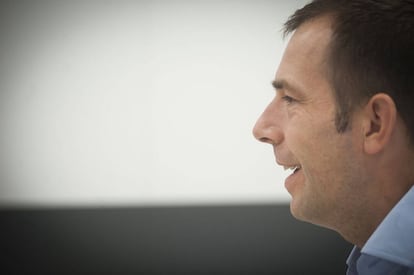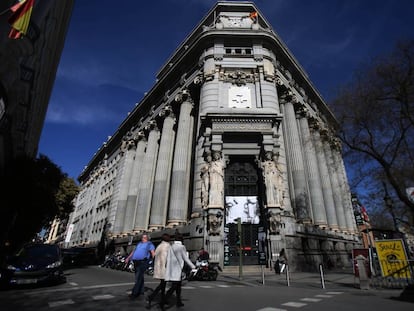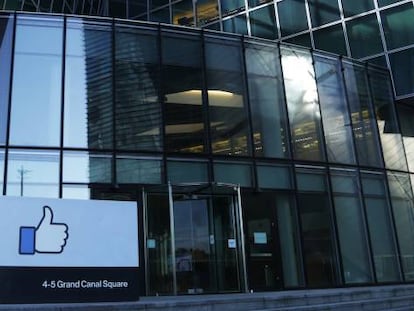How Spanish beat out French on Facebook: “It was the logical choice”
The Spaniard in charge of Facebook’s growth explains why the tech giant made the language its top priority after English

In February 2008, Javier Oliván gave a presentation in Madrid on how Facebook – back then a startup – was trying to reach the Spanish community in the Spanish language. It was held in a small theater in the center of the city, and Mark Zuckerberg was also present. Today, Oliván is one of the most well-recognized business leaders in Silicon Valley, and has brought the founder of Facebook to Spain for the World Mobile Congress in Barcelona a number of times since. Indeed, Zuckerberg said he discovered his love for Spanish jamón thanks to his colleague, who is originally from Sabiñànigo in Huesca, and who is now the company’s vice president of growth, engagement and mobile adoption.
Question: Facebook has just celebrated 10 years in Spanish. How have the company and its services changed?
It took us months to prepare the first language. It wasn’t easy at all
Answer. When I came in 2007, it was still a startup with few employees. There were around 40 million users, with the highest number in the United States, England and Australia. It was only in English. It was obvious we needed to make it available in as many languages as possible. Today the company has more than 20,000 employees and more than two billion monthly users. Now it is not just Facebook, it is also Messenger, Instagram, WhatsApp... What hasn’t changed is the mission. The goal has always been to help people connect. The ultimate objective is to foster community, to return to the roots. Having Facebook in all languages, minority languages as well, has been a big change and has led to big growth.
Q. Spanish was the first language Facebook was translated into…
A. It has nothing to do with the fact that I am Spanish, although I was the first foreigner in the company. It made a lot of sense because we were in California. We had students from Stanford who helped us with translation tools. Also it’s a language that’s relatively similar to English: it has the same alphabet. It’s not like Arabic, which has different letters and meanings.

Q. At the time, translating Facebook into Spanish was groundbreaking.
A. It was a very controversial decision. Back then, common sense told you that the norm would be to translate into French, Italian, German, Mandarin… With this you would reach a great range of the online population – almost 80%. But to connect the world without taking shortcuts, Spanish was the logical choice – but in a different way with a translation platform that allowed us to continue to innovate quickly. We made two updates a day to the program. Inspired by Wikipedia and a colleague of mine at Stanford, we allowed users to help us with the tool.
It took us months to prepare the first language. It wasn’t easy at all. In February 2008, the Spanish version was launched, although it was like boarding an airplane as it took off. Then came French, German and by the end of the year there were 40 languages. Facebook was translated into French in 24 hours. In Spain, we went from 400,000 users to four million in a year. Today there are more than 23 million users.
Q. Is it true the Spanish slang word “mola” (roughly translated as “awesome”) was suggested instead of “me gusta” for the Like button?
We are investing heavily in artificial intelligence
A. Yes, it was under debate. We asked ourselves many times how to say things that didn’t have a direct translation. The word “poke” was translated as “un toque” but we had to add the feeling that went with the action. One of the few lines of Facebook code I wrote are in this system, which invites you to chose various translation options and vote for the best. It is the algorithm that determines if a translation has enough consensus to remain as the final version.
Q. The Spanish version of Facebook came out directly without taking into account linguistic differences in each region. Why was this?
A. Initially we had the Spanish from Spain and other early versions, thinking that it would be modified by other countries, but actually we had to reduce the number of variants. The fact that there was consensus meant there was great convergence. But we did make a very clear style guide. For example, Facebook never speaks to you in the formal register, using “usted.”
Q. Were there any surprises?
A. We had a problem when there were attempts to pirate the translations, abusing the tools. It was orchestrated by big groups, but the community tends to be positive and regulates this. Most people are not there to break the rules.
Q. Is the Spanish community different to the English-speaking community?
A. The product is standard for everyone, there a not a lot of differences. What jumps out is that they are more active but we are more similar than we think, with common values, with friends and family. There is more that unites us.
Q. How are Facebook posts translated?
A. The interface is translated by the community but the content generated by the users, their posts are translated automatically. Each day, 4.5 billion posts are translated. We are investing heavily in artificial intelligence both in image recognition to explain what is happening in a photo and in translation. They are not as good as a human translation but they are 80% understandable. We know more or less what languages you speak and don’t translate these.
Q. Which countries have grown the most?
It was obvious we needed to make it available in as many languages as possible
A. The biggest growth has been in the developing world. We depend on internet adoption. Africa, Latin America and South East Asia are key points.
Q. For years all the talk has been about the use of cellphones. Now this is a reality. What has been the impact of users accessing the site directly from their telephones?
A. Mobile adoption is something we saw from the beginning. I came from telecommunications and Facebook attracted me. In the expansion team, we saw that low-range mobiles were arriving. We saw that it was a great opportunity. We bought Snaptu, an Israeli company that allowed us to adapt Facebook to any mobile. We took the deal very seriously.
In 2012, we made a big jump and had to radically change the business culture. Mobile was priority. Mark saw it clearly. I remember meetings where someone came with a new project and it was for a desktop, he would send them back and ask for a mobile version. Facebook makes much more sense for mobile.
Q. Zuckerberg has said communities are the challenge for 2018. How do you plan to focus on these?
A. At Facebook we want to create valuable human interactions. Mark has spent a lot of time thinking about this. Groups are one of the oldest Facebook products but we all have one which is especially important.
I am personally in one that is called Friends from Sabiñánigo, which is amazing. There are 2,000 members, which is more or less all the inhabitants of the town. I can find out whether it has snowed, if there is a traffic jam and tell my parents. It’s really lovely when they put up old photos. This way I can follow what is happening in my town, which in California nobody has heard of.
Q. How do you envision Facebook in the next 10 years?
A. Wow, who would have thought 10 years ago that we would be here today. The main investment areas for the next 10 years are connectivity, artificial intelligence but with a focus on understanding content, and new computing programs for mass virtual and augmented reality experiences.
English version by Melissa Kitson.









































